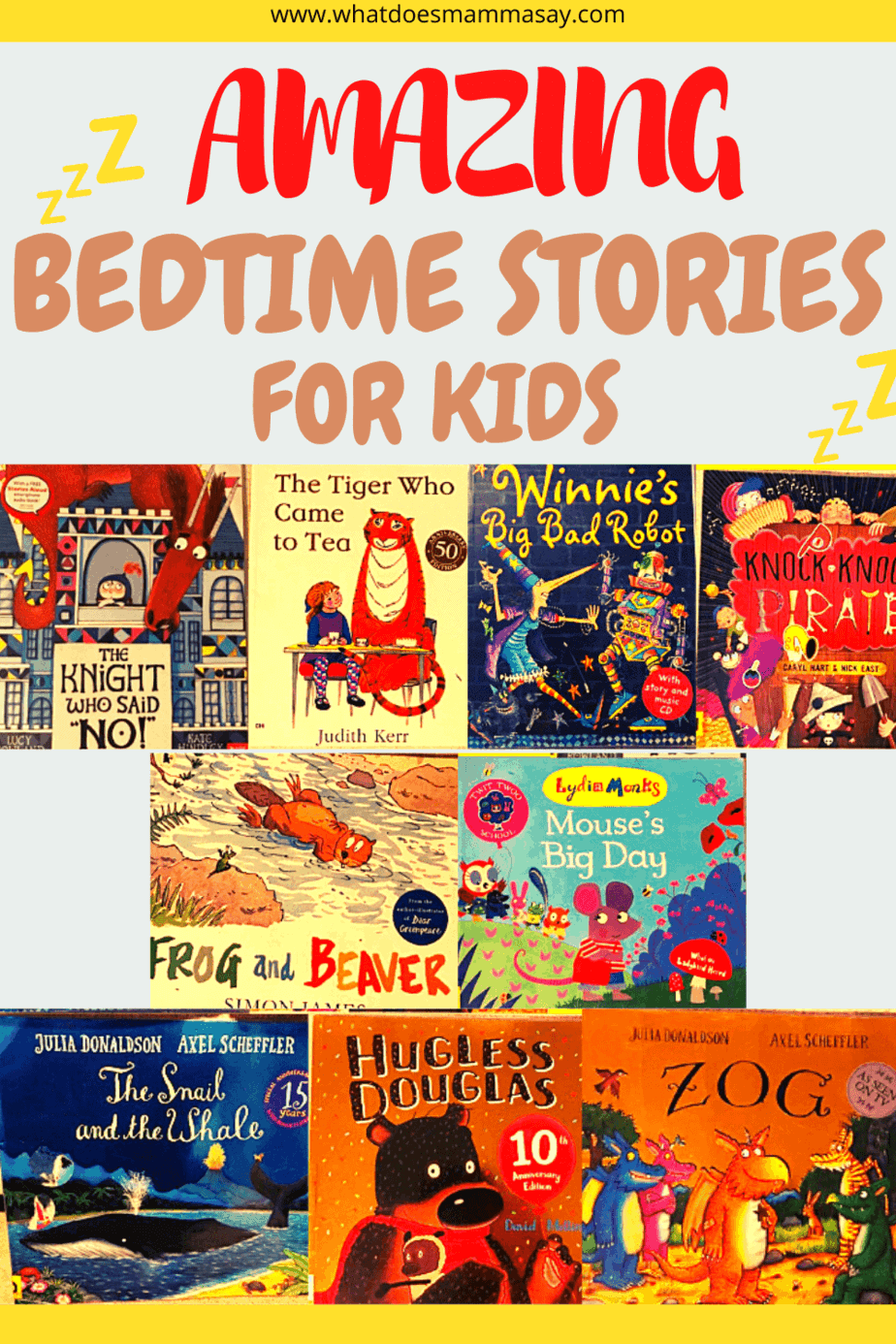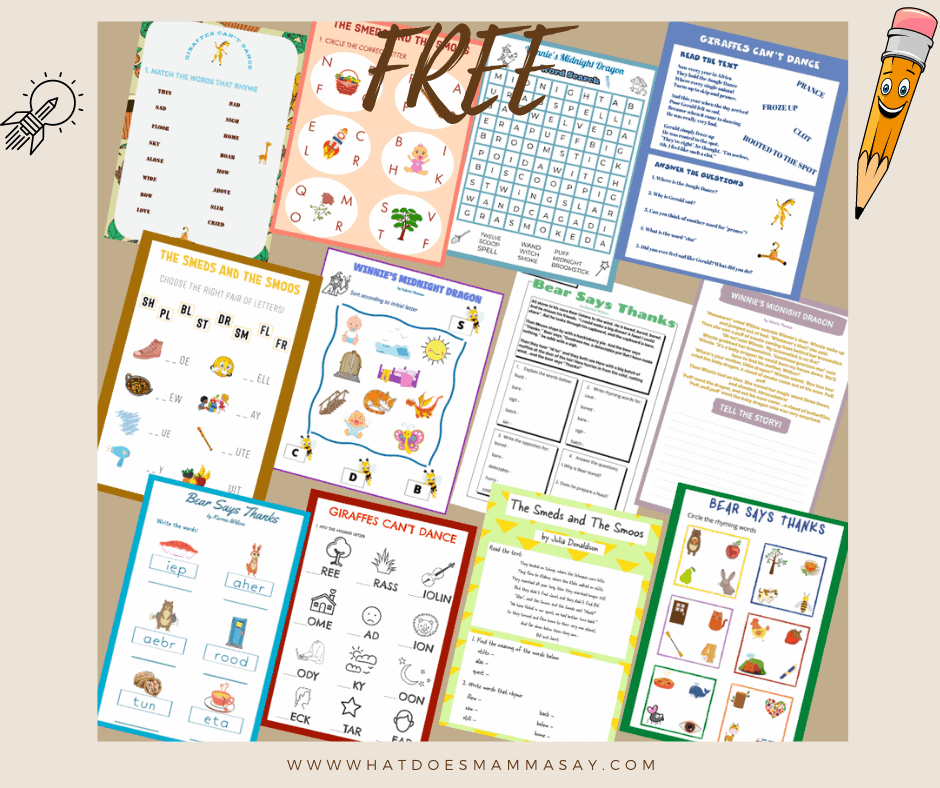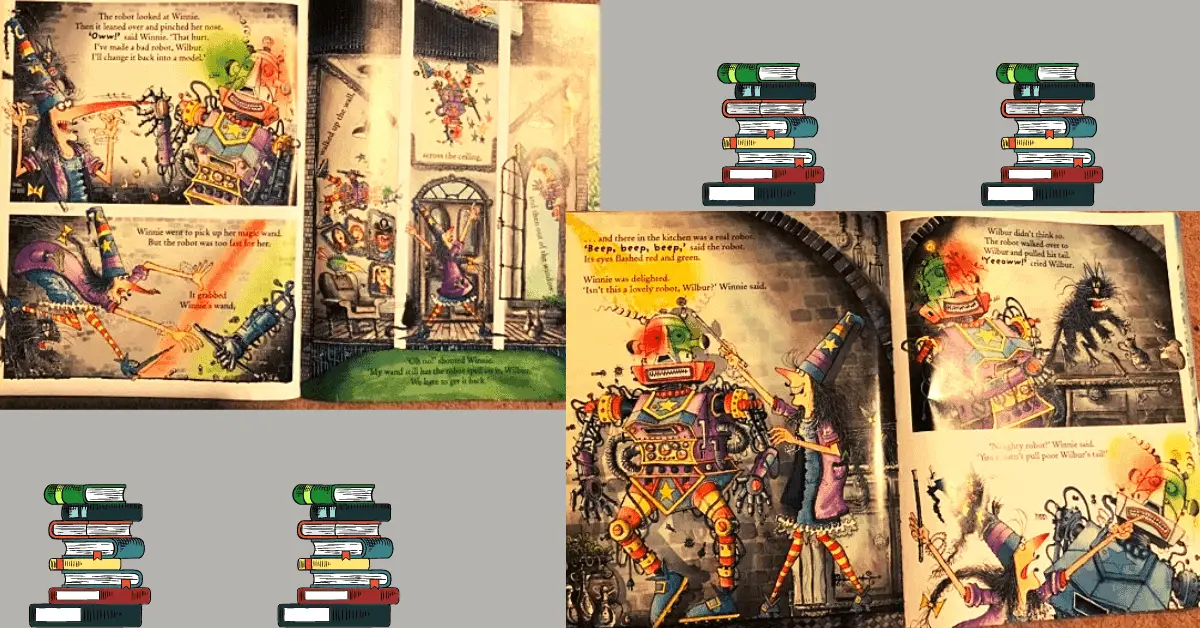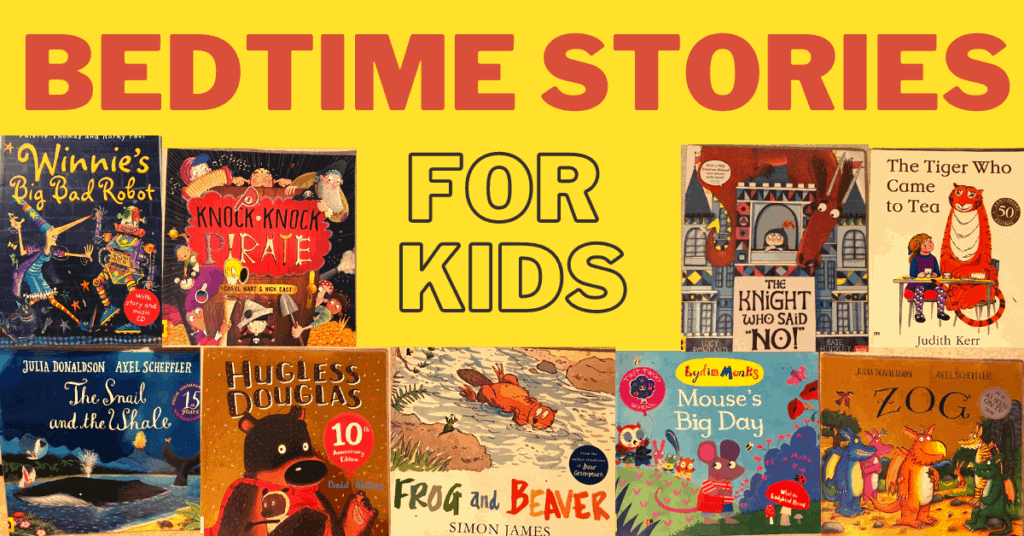This month we continue our series of bedtime stories to read to kids and create a special bonding/family moment. Last month’s list was amazing, and this month’s stories are just as great. There are funny books, books to help children self-regulate and learn about feelings, books to help children explore and all of them serve as inspiration for further exploration.
Children love books and we should encourage this and help them develop a love of reading! Explore 9 great bedtime stories and discover what your child can learn from each one!

This post may contain affiliate links and I may earn a small commission when you click on the links at no additional cost to you. As an Amazon Affiliate, I earn from qualifying purchases. You can read my full disclosure here.
Mouse’s Big Day
by Lydia Monks

The first sentence of the book reminded me of my son’s attitude towards nursery “Even though she hadn’t left home yet, she’d decided she didn’t like it”. You’ve guessed it, this is a book about a little girl’s (Mouse) reluctance to go to school. Her mum tries to convince her with the usual reasons “there will be lots of other children”, “just think about the fun things you’ll do and the exciting things you’ll learn”, “you’ll like it when you get there”.
However, Mouse will only be convinced when she gets to see for herself how much fun you can have and how nice it is to have friends. Mouse, Frog, Rabbit, Mole, and Little Owl enjoy their day out with Miss Hoot, the teacher. At the end of the day, Mouse decides that she doesn’t like school, she loves school.
Find out what books we recommend for little readers in 15 Amazing Stories For Kids.
We were both fascinated with the characters, very warm and visually-impacting. The little elements sprinkled here and there on each page kept my son engaged each time we re-read it. Overall, the book’s important lesson about school and the child-friendly illustrations made us recommend this book!
What you will learn from Mouse’s Big Day
The vocabulary is very accessible for preschoolers, but even for toddlers if they are used to being read to daily. There are words such as “mutter”, “peering”, tadpole’, “giggle” that provide excellent learning opportunities. My son is at the age when “why?” follows almost every other sentence and I take advantage of that while reading to teach him lots of synonyms, antonyms, etc.
Apart from vocabulary, your child will learn that school is a place to have fun, make friends, explore, learn new things, and feel proud of yourself. This is a great lesson to learn!
Hugless Douglas
by David Melling

My son absolutely loved this story! It is hilarious and the last two pages kept us laughing each night before bedtime. Why you may ask? Because they invite you to try out different hugs. There are group hugs, so daddy joined us, upside down hugs, come and get it hugs, don’t let me go hugs, back-to-front hugs, and many more! My son looooved them! Lots of giggles and tumbles, it became our bedtime ritual!
The story centres around Douglas, a bear who just woke up after a looong nap, and wants to hug everyone. But no one wants to be hugged! The comic situations of hugging moving bushes, trees, whipping his nose with the rabbit’s “fluffy end” were extremely amusing for my son.
The goofy characters added to the fun! But trying out the different hugs was the creme de la creme. I found them a brilliant way to end a book, out of the hundreds of books that I’ve read my son, none had such a memorable ending!
What You Will Learn From Hugless Douglas
In terms of vocabulary, children have the opportunity to discover a variety of new words. Words such as “wriggle, grunted, splinters, trotted, quivered, scooped, squirmed, wise, whooped, scrambled” can help not only native speakers but also children learning English as a second language.
The book will also teach you that group hugs are the best because all the family is involved and so much love is shared. And also, based on my son’s question “Why does he want a hug?”, I realized that the most important lesson of the book is for adults!
Why does the bear want a hug when he wakes up indeed? In fact, the book teaches adults that we need to be aware of our feelings and ask ourselves why we do what we do.
Zog
by Julia Donaldson

Once again, we returned to our favorite writer because we truly love her books. Zog is a storybook we recommend with all of our heart! It is beautifully-written, it provokes thinking and teaches children and adults alike lessons that we might sometimes overlook!
Zog is a dragon and goes to dragon school. Madam Dragon teaches little dragons to roar, fly, capture princesses, because that is what a dragon would do, right? Zog tries his best to win a golden star (competition mode on) but fails with every try. However, a little girl called Pearl, offers to be captured by Zog so he doesn’t feel sad anymore.
Grab 12 free reading comprehension and phonics worksheets seen below.

Pearl is brought to school where she nurses all the dragons when they fall. When a knight is brought to fight the dragons to save princess Pearl. Pearl decides she doesn’t want to be a princess “and prance around the palace in a silly frilly dress”. NO, she wants to be a doctor “listening to people’s chests and giving them my care”.
The knight realises he wants to be a doctor too. and Zog founds this a great opportunity for him to offer his help, he will be the ambulance. “An excellent career” decided Madam Dragon and all the dragons “gave a loud resounding cheer”!
What You Will Learn From Zog
Oh, there are so many lessons here! Deconstructing the misconception that princesses don’t need a career and they need to be prizes for brave knights! Proving that kindness can bring you so much more than fighting! Portraying a humanised figure of a creature that has constantly been attributed to the antagonist!
Teachers encouraging students to choose the path that they wish, not that they have been trained for! Amazing lessons! From a kids’ storybook of 200 words! This is the genius of Julia Donaldson that we discovered in all of her books (we read almost all)!
The Tiger Who Came to Tea
by Judith Kerr

Boy, did my son laugh the first time he saw the hungry tiger on the fridge, sitting on the chair, drinking all the tap water! Hilarious! Keeping the real proportions of the tiger was a stroke of genius. Imagine a little girl and her mummy conversing and dining with a real tiger who enjoys sitting at the table and having his afternoon tea.
The storybook was written 50 years ago so the illustrations will reflect that. They are simple, but quite memorable due to the attention paid to detail. The playful image of the tiger drinking from the pot, pouring down all the tea, going through the cupboard resonates powerfully with children.
When the tiger is finally full he leaves, but what will Sophie and her family do for dinner? Luckily, daddy comes home from work and takes the family out for dinner! The next day, Sophie and her mum go shopping, and Shopie buys a LARGE can of tiger food, just in case. But the tiger never came back again!
What You Will Learn From The Tiger Who Came to Tea
Your little one will surely enjoy absurd situations, exaggerated ones, and this book delivers plentiful! Children learn to love the tiger from the first few pages and they discover, alongside Sophie, how funny life would be with a large wild animal for a pet! Sharing is important, a convincing message that the author illustrates throughout!
In terms of language, the vocabulary is very accessible for preschoolers and toddlers alike. All the words are commonly used in everyday situations, with which all children can relate. “He ate all the supper that was cooking in the saucepans, and all the food in the fridge, …and all the packets and tins in the cupboard….and he drank all the milk, and all the orange juice, and all Daddy’s beer and all the water in the tap.”
Therefore, learning vocabulary is not the essence of the book, but rather capturing the imaginative and humorous illustrations that make the book timeless.
Knock Knock Pirate
by Caryl Hart and Nick East

This little girl’s pirate story teaches her how to count, while enjoying a gripping adventure. If you want to teach your little one to count to 10 in a natural and funny way, use this pirate storybook. He will love it! The vivid illustrations, rich details, and memorable characters, together with an engaging plot, make this book worth-while!
And if your child is passionate about pirates, all the better. Children will be captivated by the grannies flying on cannonballs, the grandads scratching their fleas, or the house that suddenly goes sailing “The whole house shakes beneath my feet/ Then sails away along the street”.
More suitable for preschoolers and older children, the rich vocabulary is packed with pirate specific words: “hoist the mainsail, rigging, haul in the anchor, dance a jig, drop the anchor”, weather vocabulary “a dreadful gale, swirling whirlwind” and lots more adventure-packed words “monsters lurk, the squid squirts ink, the sharks swarm, the seven seas we roam”.
What You Will Learn From Knock Knock Pirate
Exploring children’s brilliant imagination, this book offers endless possibilities for children to own their play. They will be inspired by the images of grannies flying on cannonballs, by the house that suddenly sets sail, by the babies tying nappies into sailors’ knots, the pirate shark, and the fascinating adventure the girl experiences while home alone.
This is a rhyming storybook making it easier for children to learn chunks of language and also to feel engaged by the rhythm of it. We were fascinated by the captivating illustrations, dynamic and memorable, filled with tiny elements to be discovered.
The Snail and the Whale
by Julia Donaldson

We already mentioned how much we love Julia Donaldson’s books. That is why we included another of her storybooks on this list. Read 7 great bedtime stories to discover more of Julia Donaldson’s books. The Snail and the Whale is the adventure story of two contrasting characters who travel the world together.
The biggest animal on the planet teams up with one of the tiniest creatures to embark on a fascinating journey across the world. The snail initiates the adventure, as he is eager to explore, learn and admire the wonders of the world “The sea is deep and the world is wide! How I long to sail, said the tiny snail”.
Parents, read a bedtime story is all about the importance of books in children’s lives and the impact of their future.
Soon, the whale is stranded on the beach because of humans “upsetting the whale with their earsplitting roar, Making him swim too close to the shore”. The tiny creature manages to save the whale’s life, an amazing message that even the tiniest can make a huge difference!
When the snail and the whale get back, they tell their tale to all the other snails, which inspires them to be brave as well “The humpback whale held out his tail/ And on crawled snail after snail after snail”.
What you Will Learn From The Snail and the Whale
Once again, the vocabulary is amazing and easy to remember as this is a rhyming-book. There are words such as ‘ slither, gaze, long to, wriggle, loop, shimmering, starlit, fiery, towering, frolicked, hideous, earsplitting” which abound, making it more suitable for older children. Axel Scheffler’s illustrations are as memorable as ever. Unique, captivating, charismatic, beautifully capturing the words.
The message of the story is ageless: be brave, dare, dream, explore. Children may resonate more powerfully with this message but as adults, we cannot but feel encouraged to dream too.
Frog and Beaver
by Simon James

This book for kids is a simple story of friendship and help. Frog and his friends, the duck and ducklings, the water vole and baby water voles, were leading a happy, simple life on the river. Until beaver moves in the area. Beaver is determined to build the biggest dam, unaware of what this might mean for the other animals on the river.
The water supply starts to get lower and lower until the animals are forced to move upstream. However, soon the dam breaks and the water comes crashing through, almost killing Beaver and destroying all the houses. Frog saves Beaver’s life. As a thank you, Beaver helps all the animals build their houses again and learns his lesson. ” He learns that size is not important and everything he builds now is “not too big though”.
What You Will Learn From Frog and Beaver
My son enjoys the goofy characters and the simple, almost sketch-like drawings. The book is based on nature illustrations that appeal to children. And as ever, animal characters prove to be loveable and charming, child-approved for sure.
Vocabulary-wise, the words are accessible and don’t challenge much. There are some new words that children can learn, such as “blooming, dam, upstream, mutter, creak, crash, tumble” that can improve your child’s vocabulary of English as a second language.
The moral of this storybook can easily be discovered by children themselves if you ask the right questions”Why did Frog save Beaver’s life?” “What did Beaver do differently after that? “. All in all, I was pleased to see that my son loved the book and I am sure that other children will love it too, so we highly recommend it!
The Knight Who Said No
by Lucy Rowland

I am very happy we chose this amazing storybook for kids. It teaches children about emotions and how to self-regulate, which is very important, yet so difficult for little ones. The main character is a knight who is a loveable and good little boy. He always says yes, is eager to help and likes to please everyone. Until one day, he starts to feel “quite odd: all hot inside; and cross from top to toe”.
And then he starts to answer “NO”! As a sort of rebellion, he tells everyone “No”, including the dragon who comes swooping through the sky. He confronts the dragon, but discovers that the dragon was just as sad and lonely as he was. The solution to all of his anger? Befriend the dragon! They become the best of friends, helping each other and playing all day.
The end is beautiful. From that day on “Mostly Ned would answer “Yes”/ But sometimes Ned said No”. This is an ending that offers great opportunities to explore your own child’ understanding of his feelings. Why does he say no? When? Is it ok to say No? Why does he say mostly say yes? When? How does he feel? When do you feel like that?
What You Will Learn From The Knight Who Said No
Self-regulation, understanding emotions and why we feel what we feel, learning about boundaries and acceptance, are all essential lessons for your child’s social and emotional development. That is why I highly recommend this book, apart from the beautiful story per se.
The illustrations are quite unique, visually-appealing to children, the plot is intriguing and the end unpredictable. The attention paid to detail engages the child and captures his attention every time you read the book.
Vocabulary-wise, there are a multitude of words that can help little children improve their communication and language skills. Words such as ” whine, swoop, holler, groan, fetch, off, cross, lad, soar” are a great resource for bilingual children, but also for native speakers of English.
Winnie’s Big Bad Robot
by Valerie Thomas

My son fell in love with the Winnie the Witch collection not long ago. He picked the book himself and was fascinated. At first, I thought he might now enjoy the bizarre illustrations, but he absolutely loves them! They are indeed unique.
Imagine a 40-year-old single witch, and her black cat, living all alone in a huge castle, where you find spiderwebs everywhere, creepy crawlies, and all sorts of weird animals. This strange, yet lovable witch leads a normal/almost normal life. She goes to museums, celebrates birthdays, takes drawing classes, goes to the beach and uses a computer.
In this book, Winnie is at the museum, enjoying herself. She is making a robot in her arts class, alongside other children. Once she is done, she takes the robot home. The beauty of the Winnie the Witch collection is that each normal every-day life episode is invigorated with some magic spells.
The robot comes to life and using Winnie’s magic wand, turns everything insight into robots: ducks, rabbits, birds, Winnie’s house, even Winnie. Wilbur manages to save the day and helps Winnie recapture her wand and turn everything back to normal.
What You Will Learn From Winnie’s Big Bad Robot
With every single book of the collection, your little one will discover a memorable universe, where everything is possible with the help of the magic wand. The magic wand may be a symbol of children’s imagination that can take them everywhere and make everything possible.
These books simply offer some inspiration to help children understand that there is no end to their imagination. Amusement and imagination go hand in hand and this is what this book teaches us.
We also love the vocabulary range and the opportunity it offers to improve communication. Your child will constantly be exposed to dialogue, rich vocabulary, and plot twists that make learning even more memorable. My son learnt new words from this book “cross, delighted, blithering broomsticks, creeper, snatched, a pile of junk, deckchair” which were not above his level and were sprinkled all over in the story.
Final Thoughts on this Month’s Bedtime Stories
Every month we will recommend the most interesting and fun bedtime stories we read and think others might enjoy. Children need books to keep them curious and learning, to help them explore different worlds and ideas, to stir their imagination and engage with different ways of thinking.
Use bedtime stories as an opportunity to offer children all these. And much more.
“Families are pivotal in terms of facilitating children’s language development, including their ability to read. ” (Journal of Early Childhood Research) Learn more about how important reading is and what type of books you can use to make children become independent readers. It is our responsibility therefore to encourage a love of reading from an early age.
As always, I will encourage you to ” Get a book!“
We share all of our ideas on our Facebook group Learning Activities for Kids.

Hi. I am Monica, an experienced ESL teacher and early years student, mother to a preschooler and passionate reader.


Every book in the collection will introduce your child to a memorable realm in which anything is possible with the aid of a magic wand. Thank you!